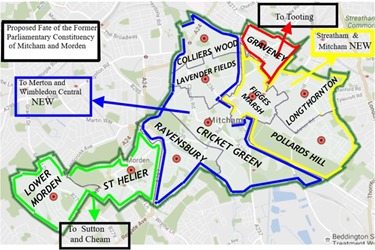
Read Siobhain's letter to the Boundary Commission, as part of its second consultation, below. The first consultation
proposed the abolition of Mitcham & Morden.
Chief Executive
The Boundary Commission for England
35 Great Smith Street
London
SW1P 3BQ
Dear Sir/Madam,
RE: Second consultation Boundary Commission
I am writing with regard to the second round of the Boundary Commission’s consultation.
Thank you for taking the time to listen to Mitcham & Morden residents in October. I was pleased that so many residents articulated their concerns regarding plans to split our local community up.
In my earlier submission, I set out my concerns as the parliamentary representative of this area, of the unwise suggestion to split up the historic parishes of Mitcham and Morden. In fact, this runs against the Commission’s own guidelines to keep established communities together. I am pleased that so many submissions make clear that the community of Mitcham includes not only Figges Marsh, Longthornton and Pollards Hill (as stated in the Commission’s initial proposals), but also Graveney, Colliers Wood, Lavender Fields, Cricket Green and Ravensbury.
It is for this reason that I was very disappointed by submissions that seemed to misunderstand our area. In particular, BCE-33279 suggests that the community of Mitcham includes only three wards, those of Figges Marsh, Longthornton and Pollards Hill. As such, it proposes to split Mitcham straight down the middle, placing the other Mitcham wards of Cricket Green, Lavender Fields, and Ravensbury in ‘Merton & Wimbledon’.
To reiterate my previously expressed concerns, this would be disastrous for our local community. Much of the residents in these three wards have Mitcham postcodes (CR4), they head to Mitcham town centre for their shopping, and they send their children to Mitcham schools. These residents share no community identity with Wimbledon. In comparison to Mitcham, Wimbledon is far less diverse, much more affluent, and has nothing in common with Mitcham. I share the frustration of Mitcham residents at the prospect of being pushed arbitrarily to the outskirts of another community so that the Wimbledon seat reaches its quota number of electors, at the expense of Mitcham residents having the political representation they need.
I was also frustrated to read that BCE-33279 suggests moving both Colliers Wood and Graveney into the Tooting constituency. Similarly BCE-28274 suggests moving the Colliers Wood ward into ‘Wimbledon Common’.
Once again, this demonstrates a lack of understanding of our area. Colliers Wood has historic links with the parish of Mitcham, and one of its five polling districts is exclusively CR4 (the Mitcham postcode). To illustrate this point, at the heart of our ward is Christ Church, which has historic links with the parish of Mitcham that date back to the nineteenth century.
I cannot stress highly enough how little Colliers Wood has in common with either Wimbledon or Tooting. We look to Mitcham– that is our local community. We are very much in the east of Merton borough, the poorer and more diverse half, and ‘Wimbledon’ is in the west. Just because Colliers Wood has a tube station on the Northern Line, that certainly does not mean that we have closer links with Tooting. Most of the custom on Colliers Wood high street comes from Mitcham. Tooting residents very rarely come to Colliers Wood for their shopping, and Colliers Wood residents are much more likely to look to Mitcham as their local community. In addition, placing these north Mitcham wards in a Wandsworth-dominated parliamentary constituency would neglect the needs of these Merton wards.
Therefore, while BCE-28274 provides a much better alternative to the community of Mitcham, it still fails to keep the whole of Mitcham together.
Furthermore, Lavender Fields, Cricket Green and Ravensbury have predominantly CR4 postcodes, and look to Mitcham town centre – half of which is in Cricket Green and half in Figges Marsh. You may be aware that Lavender Fields takes its name from Mitcham’s historic lavender industry. During the 19th and early 20th century, much of north-east Mitcham was covered by lavender fields, which had an international reputation for its lavender oil, soaps and cosmetics. As such, the alternative proposals to split Mitcham up in this way disregard its history and community.
I would very much like to recommend to the Commission the submission by Mr John Bryant (BCE-28349). While I cannot comment on the impact of Mr Bryant’s suggestions on the rest of London, his proposals rightly keep the whole of Mitcham together, uniting the wards of Colliers Wood, Graveney, Figges Marsh, Cricket Green, Lavender Fields, Longthornton, Pollards Hill and Ravensbury, under the new constituency of ‘Mitcham’.
Mr Bryant’s plans would also unite the historic St Helier estate, which is split between two different constituencies, uniting the wards of Ravensbury, St Helier (Merton), St Helier (Sutton) and Wandle Valley (Sutton).
I sincerely hope that these concerns will be prioritised in the next iteration of the Commission’s consultation.
Best wishes,
Siobhain McDonagh MP